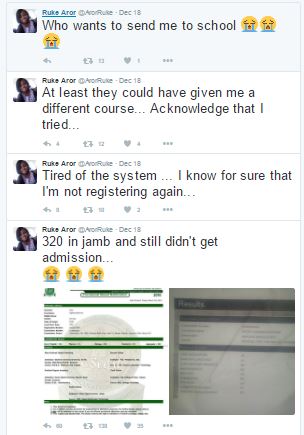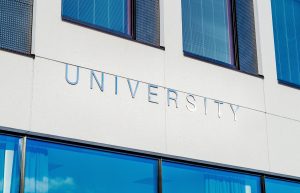
This post is based on data extracted from a presentation during JAMB’s 2018 policy meeting, delivered by the Registrar, Professor Ishaq Oloyede, in June 2018. All referenced data in this post are on the year 2017 – except where otherwise stated – and derived from the PDF of the presentation slide, which is downloadable from JAMB’s website under the title “Presentation by the Registrar at the 2018 Policy meeting”. I have no professional or personal relationship with JAMB or its management team.
For each point I raised in the post, I have made assumptions at the beginning of each point based on policy statements or innuendo that tend to come up during public discourse on issues that relate to higher education admissions in Nigeria. Hence, the assumptions are in bold for emphasis.
We appealed to some universities and other tertiary institutions to admit all the blind candidates that met the minimum requirement for admission in the 2017 UTME.
– Ishaq Oloyede (JAMB’s Registrar)

Public schools in Nigeria should provide inclusive education. The national policy on education (2013) in Section 3 (d) emphasises inclusive education for every Nigerian when it states that “education is compulsory and a right of every Nigerian irrespective of…any peculiar individual challenges”. However, JAMB’s 2017 admissions’ record shows that only 250 visually impaired candidates sat for the UTME and just 145 candidates were granted admissions into the Nigerian higher education sector, and this was achieved as a result of JAMB’s management special intervention that the institutions should admit ‘blind candidates’ that met the minimum admission requirements. I have lumped ‘blind candidates’ under Special Educational Needs and Disabilities (SEND) for the purpose of this post. Although, it is important to note that the admission of the 145 candidates is a ‘significant’ improvement from the 44 and 72 candidates that were admitted in 2014 and 2015 while the increase between 2016 and 2017 was marginal at 142 and 145 candidates, respectively. But it should be noted that three institutions: Federal College of Education (Special), Oyo, the University of Lagos and the University of Jos accounted for over 50% of the 145 candidates admitted at 31, 30 and 20 admitted candidates respectively.
Furthermore, it is important to note that the challenges faced in the Nigerian SEND education sector lie further down the education pyramid, particularly at the early years (0-4 years old), compulsory education (5-15 years old) and senior secondary education (16-18 years old) levels. So, to address the issue of the abysmal number of SEND applicants in the UTME, there is need to address the fundamental issues that relate to providing inclusive education in the country’s public education sector between the early years and senior secondary education periods.
The policy of catchment states is to pull down one part (South) of the country because of another part (North) of the country. However, the reality from JAMB’s data shows that federal universities are regional champions and mainly accept students under the catchment states policy from within their geopolitical regions, except for the University of Abuja that has all the 36 states of the federation including the FCT as its catchment states and Ahmadu Bello University (ABU), Zaria in Kaduna state has a catchment states coverage of twenty (20) states, spanning three geopolitical regions. As for the other federal universities that JAMB published their catchment states list in the report, they all restricted their catchment states to provision to states that were mainly in their geopolitical regions.

JAMB introduced the admission pass mark of 120 to favour candidates from the educationally less developed states, particularly those from the northern part of the country. Well, this is another misinformation because there were more institutions (128) from the South that admitted ‘candidates with score less than 140’ than institutions from the North (111) that admitted candidates with similar scores. Although, more candidates with states of origin from the North (99) were admitted as against 35 from the South. However, the total number of candidates admitted with a score below 120 from both the North and South were 134 (0.3%) as against the overall number of 566,641 candidates admitted in the year.

Admission into Nigerian higher institutions is highly competitive, hence, there is need for the establishment of new higher institutions in the country. If only this notion is the reality as JAMB recorded that 44.7% of the admission vacancies in 2017 were ‘unused quota’, that is 457,846 admission vacancies, as against the 566,641 (55.3%) admission vacancies used. However, without maximising the present provisions there is no educational, economic or political justification to establish new higher institutions by either the federal government.

Lagos state is an educationally advanced state. This notion seems plausible on the surface but by studying the data set for 2017, Lagos state had only 31,437 candidates – 1.9% from the total number of candidates that sat for the 2017 UTME in the country – that claimed Lagos state as their state of origin. Hence, nationally, Lagos state was 21st (31,437 candidates) in terms of applications into tertiary institutions in the country, and was well below states like: Imo (1st – 93,048), Oyo (2nd – 86,687), Edo (7th – 66,552), Kaduna (8th – 65,992), Kano (9th – 64,818), Benue (12th – 63,116) and Nasarawa state (20th – 36,225). However, there were 234,627 (14.19%) candidates who sat for the UTME in the state as against Nasarawa state at 5th position with 56,334 candidates and Katsina state that was 21st with 25,894 candidates.

There is high need for people with vocational skills in the country’s economy, hence, young people should be encouraged to apply to technical, vocational education and training (TVET) institutes. Well, it seems most students or families are not buying into the narrative. Only 236 (0.04%) candidates out of the 566,641 admissions issued in the year went to candidates that opted for the National Innovation Diploma (NID). Perhaps, it is a case of the government and many people not putting their money where their mouth is or the government and many adults are advancing a viewpoint that the TVET is essential while they themselves or the youths are not convinced of its viability.

JAMB as an examination body lacks integrity. This claim cannot be rejected with a wave of a hand like a magic wand because examinations, particularly major external or terminal examinations in the country are known to be notorious or fraught with examination malpractices. Hence, every major external or terminal examination in the country is easily and highly susceptible to examination malpractices. As such, as a non-observant commentator it is almost impossible to defend a procedure that I didn’t experience personally. However, based on the Registrar’s presentation under review here, JAMB as a body claimed to have made efforts to protect the integrity of its examination and admission processes, from inception during the purchase of the examination form up to the conduct of the examination and during the admission process. Although, there is an obvious need to attend to problems that relate to the lack of access to technology by candidates that live in the remote or rural areas, and also those that are socioeconomically disadvantaged who might be unable to fully utilise or access the systems put in place by JAMB.
Some of the strategies that JAMB stated that it put in place to protect the integrity of its examination and admission processes covered the: registration process, conducting of the examination, admission process and verification of JAMB’s admission documents – result slip and admission letter.
Lastly, it is illogical to make any valid or reliable conclusion based on a single year’s data, hence, there is need for further comparisons of data from different years. However, it is important to look into the data over a period of time and see if the 2017 data was just a one-off or if it was a recurrent pattern. Thus, approaching the issue using a longitudinal study by making comparisons based on variables like: states of origin vs states of examination; educationally less developed states vs educationally advanced states; male vs female applicants; male vs female admissions; first time candidates vs re-sit candidates; first choice admissions vs non-first choice admissions; programme (course) of first choice vs programme (course) of admission etc. By shedding light on such indices, hopefully, it will be possible to provide better policy changes that will address the inequalities and needs within the country’s higher education sector.
If you have experience or views to share on the issue, please make your comment(s) below in the comment section.
Please, leave your thoughts on this post in the comment section and feel free to share the article with your contacts.
Thanks for taking out of your precious time to read my article/s!
If you like this post, kindly subscribe and/or follow me on Twitter @otukogbe and @EdusoundsNg or on Facebook at edusoundsng.




